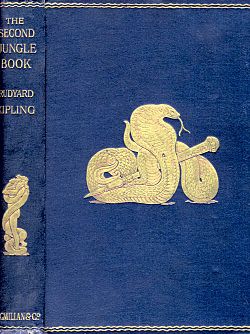This article needs additional citations for verification .(March 2024) |
English Wikisource has original text related to this article:
 Gilt-stamped cover from the original edition of The Second Jungle Book, based on interior illustrations by John Lockwood Kipling. The front cover depicts the white cobra from "The King's Ankus"; the spine art shows Mowgli and Kaa wrestling from the same story. | |
| Author | Rudyard Kipling |
|---|---|
| Illustrator | John Lockwood Kipling (Rudyard's father) |
| Language | English |
| Series | The Jungle Book |
| Genre | Children's book |
| Publisher | Macmillan Publishers |
Publication date | November 1895 |
| Publication place | United Kingdom |
| Media type | Print (hardback & paperback) |
| Preceded by | The Jungle Book |
The Second Jungle Book is a sequel to The Jungle Book by Rudyard Kipling. [1] First published in 1895, it features five stories about Mowgli and three unrelated stories, all but one set in India, most of which Kipling wrote while living in Vermont.
Contents
All of the stories were previously published in magazines in 1894–5, often under different titles. The 1994 film The Jungle Book used it as a source.